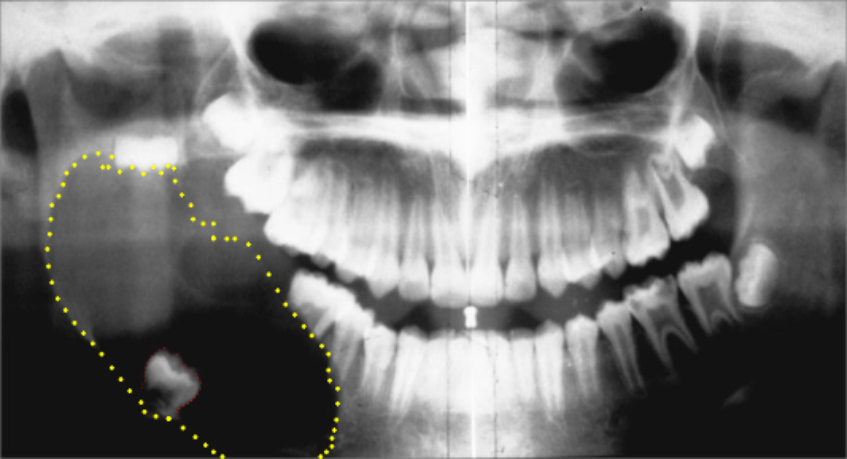Dentigerous Cyst
What is a Dentigerous Cyst?
The second most common tooth-derived cyst is the dentigerous cyst, which develops around the crown of an unerupted tooth.
What are the causes of dentigerous cysts?
It most frequently is found in areas where unerupted teeth are found: wisdom teeth and upper jaw canines, in decreasing order of frequency.
What are the signs & symptoms of dentigerous cysts?
These cysts can grow very large and can move teeth but, more commonly, they are relatively small.
Most dentigerous cysts are asymptomatic and their discovery is usually an incidental finding on taking an X-ray of the mouth.
Dentigerous cysts can become quite large and can place the patient at risk from a pathological jaw fracture.
Dentigerous Cysts – Key Features
- Arise in bone & contain the crown of an unerupted tooth which is usually displaced
- Are most frequently associated with unerupted 3rd molars (wisdom teeth) and canines
- Clinical & radiographic features usually provide an accurate pre-operative diagnosis but confirmation is histological
- Responds to enucleation or marsupialisation and does not recur after treatment
- May be mistaken radiographically for an odontogenic keratocyst or ameloblastoma
How is it treated?
Teeth that have dentigerous cysts associated with them are removed together with the cysts.
The cysts are sent off for closer scrutiny under the microscope.
Once removed, they are very unlikely to come back.
Impacted teeth with small areas of shadowing around their crowns (suggesting the presence of normal dental follicle rather than dentigerous cyst) also may be monitored with serial X-rays. Any increase in the size of the ‘shadowing’ should prompt removal and microscopic analysis.
Useful Articles & Websites
Radiographics 1999. Cysts & Cystic Lesions of the Mandible
Int J Clin Ped Dent 2010. Dentigerous Cyst of Inflammatory Origin
Imaging Sci Dent 2012. Dentigerous Cyst associated with an Impacted Mesiodens – Report of 2 Cases
Rhinology 2012. Dentigerous Cyst from Supernumerary Teeth
Int J Clin Ped Dent 2013. Management of a Dentigerous Cyst – A Two-Year Review
Int J Head Neck Surg 2013. Dentigerous Cyst of the Mandible
Int J Sci Study 2014. Dentigerous Cyst Associated with an Erupted Tooth – An Unusual Presentation
Dental Update 2015. Odontogenic Cysts – An Overview
JOMS 2015. Multiple Dentigerous Cysts – A Case Report & Review
Dent J 2019. Unusual Imaging Features of Dentigerous Cyst – A Case Report
University of Missouri-Kansas City School of Dentistry. Cysts of the Jaws
Power Point Presentation about the Origin of Odontogenic Cysts & Tumours



